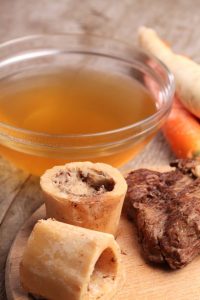Gettin Cozy is the New Healthy
I can’t think of a more “cozy” food than homemade bone broth. And, it’s also one of the most nutritious foods available. Bone broth is a foundational traditional food in nearly every culture. It’s what is made from the leftover bones, and cartilaginous parts of animals after they are slaughtered – most of these parts are merely thrown away today. These bones, and cartilage is incredibly dense in amino acids, minerals and healthy fats, is also where the delicious marrow is. By slow cooking the bones in water over a day or two, many of these nutritious elements are extracted into a dense broth that is not only a health powerhouse, but also tastes delicious.
Makes a Wonderful Alternative to Recipes that Call for Lard
Bone broth is a foundational element in any gourmet restaurant, because it enhances the flavor and richness of anything it’s used to make. It can be used as a soup stock, to make gravies, to make rice or risotto, or drank by itself. When making broth, a thick layer of fat will settle on the top of the broth, which can be skimmed off and used to saute, or in baked goods, like pie crust. This is an amazing alternative for those of us who have our grandmother’s recipes that call for “lard” but don’t want to use conventional lard because of its questionable quality. If you use grass fed organic bones for your bone broth, the fat matrix of the fat you skim off the top will be higher in HDL, and lower in LDL, and will not contribute to a raise in cholesterol in the same way as lesser quality fats and animal products do. This is a crucial point which traditional food enthusiasts, such as Weston Price, have pointed out for generations.
Bone Broth Can Be Used in a Fast for those who don’t Fast Well
There is a specific list of common ailments that respond incredibly well to bone broth as part of a treatment plan. Anytime the diet is in question, and a fast is recommended, bone broth is likely to be an alternative for those who don’t fast well. It contains enough nutrients and fat to keep energy levels up, and is nearly universally tolerated by even the most severe gastrointestinal pathologies.
Here is a short list of specific reasons people have used bone broth:
- Helps repair “leaky gut” syndrome
- Helps overcome food intolerances and allergies
- Helps Improve joint health
- Helps reduce cellulite
- Boosts the immune system
Bone Broth: Natural Multi-Vitamin
Chapters could be written on each of the uses above, and exactly how bone broth functions in each instance. To simplify things, bone broth is essentially a “natural multi-vitamin,” containing more than 19 essential and non-essential amino acids, collagen and gelatin, which is necessary for forming healthy connective tissue, and nutrients that are specifically supportive of the digestion and immune system, like glutamine. If there’s one thing you could add to a diet that would drastically improve health, bone broth would be it.
I have used the following recipe for years to make broth, and once you’ve done it a few times it gets relatively simple.
Node’s Bone Broth

Ingredients (per gallon of water):
2 lbs collagenous bones
2 tablespoons vinegar
1 onion
2 shallots
2 large carrots
2 celery stalks
1 tablespoon pepper
1 tablespoon salt
1/2 bunch of parsley – added last 30 minutes (after two days simmer)
4 cloves garlic – added last 30 minutes (after two day simmer)
Cooking Instructions:
To maximize the mineral release, as well as the flavor, there are 2 preliminary steps to undergo to prepare the bones. First, roast the bones with coconut oil at 350 degrees for approximately 30 minutes. This will unlock the flavor of the bones. Next, place the bones in the stock pot with enough water to cover and add vinegar; let sit for 20-30 minutes. The acid in the vinegar will increase the solubility of the minerals contained in the bones, which means that the mineral content of the stock will increase.
Now add onions, shallots, celery, carrots, salt and pepper and water, bring to boil and let simmer for 48 hours. The collagen and minerals from the bones will begin to degrade and infuse stock with calcium, manganese, magnesium, copper, and other trace minerals as well as glycine and proline, 2 amino acids that are vital to healthy connective tissue. The bone marrow from any long bones used will also make its way into the broth and add wonderful flavor and texture (as well as added protein).
30 minutes before taking the broth off simmer, add parsley and garlic, and additional salt and pepper to taste.
The broth should have a layer of oil and fat on the top, this is good. This fat is extremely healthy (if the bones used are from grass fed animals), and will actually help lower LDL and raise HDL (bad and good cholesterol respectively), as well as lowering triglycerides.
Allow to cool before freezing in ziplock bags
Image Copyright: <a href=’https://www.123rf.com/profile_ninamalyna’>ninamalyna / 123RF Stock Photo</a>
 Node Smith, ND, is a naturopathic physician in Portland, OR and associate editor for NDNR. He has been instrumental in maintaining a firm connection to the philosophy and heritage of naturopathic medicine among the next generation of docs. He helped found the first multi-generational experiential retreat, which brings elders, alumni, and students together for a weekend camp-out where naturopathic medicine and medical philosophy are experienced in nature. Four years ago he helped found the non-profit, Association for Naturopathic ReVitalization (ANR), for which he serves as the board chairman. ANR has a mission to inspire health practitioners to embody the naturopathic principles through experiential education. Node also has a firm belief that the next era of naturopathic medicine will see a resurgence of in-patient facilities which use fasting, earthing, hydrotherapy and homeopathy to bring people back from chronic diseases of modern living; he is involved in numerous conversations and projects to bring about this vision.
Node Smith, ND, is a naturopathic physician in Portland, OR and associate editor for NDNR. He has been instrumental in maintaining a firm connection to the philosophy and heritage of naturopathic medicine among the next generation of docs. He helped found the first multi-generational experiential retreat, which brings elders, alumni, and students together for a weekend camp-out where naturopathic medicine and medical philosophy are experienced in nature. Four years ago he helped found the non-profit, Association for Naturopathic ReVitalization (ANR), for which he serves as the board chairman. ANR has a mission to inspire health practitioners to embody the naturopathic principles through experiential education. Node also has a firm belief that the next era of naturopathic medicine will see a resurgence of in-patient facilities which use fasting, earthing, hydrotherapy and homeopathy to bring people back from chronic diseases of modern living; he is involved in numerous conversations and projects to bring about this vision.
